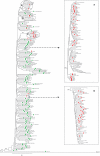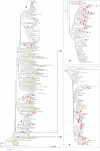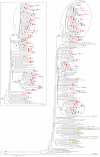New trends of HCV infection in China revealed by genetic analysis of viral sequences determined from first-time volunteer blood donors
- PMID: 20196805
- PMCID: PMC3020328
- DOI: 10.1111/j.1365-2893.2010.01280.x
New trends of HCV infection in China revealed by genetic analysis of viral sequences determined from first-time volunteer blood donors
Abstract
Recently, we studied hepatitis C virus (HCV) sera-prevalence among 559 890 first-time volunteer blood donors in China. From randomly selected 450 anti-HCV positive donors, we detected HCV RNA in 270 donors. In this study, we amplified HCV E1 and/or NS5B sequences from 236 of these donors followed by DNA sequencing and phylogenetic analysis. The results indicate new trends of HCV infection in China. The HCV genotype distribution differed according to the donors' region of origin. Among donors from Guangdong province, we detected subtypes 6a, 1b, 3a, 3b, 2a, and 1a at frequencies of 49.7%, 31.0%, 7.6%, 5.5%, 4.1%, and 2.1%, respectively. Among donors from outside Guangdong, we detected 1b, 2a, 6a, 3b, 3a, 6e, and 6n at frequencies 57.1%, 13.2%, 11.0%, 9.9%, 4.4%, 2.2%, and 2.2%, respectively. Although we found no significant differences among regions in age or gender, subtype 6a was more common (P < 0.001) in donors from Guangdong than those from elsewhere, whilst subtypes 1b (P < 0.02) and 2a (P < 0.001) were more frequent outside Guangdong. Disregarding origins, the male/female ratio was higher for subtype 6a-infected donors (P < 0.05) than for subtype 1b donors, whilst the mean age of subtype 2a donors was 8-10 years older (P < 0.05) than that for all other subtypes. Detailed phylogenetic analysis of our sequence data provides further insight into the transmission of HCV within China, and between China and other countries. The predominance of HCV 6a among blood donors in Guangdong is striking and mandates studies into risk factors for its acquisition.
Figures




References
-
- World Health Organization Hepatitis C global prevalence. Wkly Epidemiol Rec. 1999;74:425–427. - PubMed
-
- World Health Organization Hepatitis C. Wkly Epidemiol Rec. 1997;72:65–69. - PubMed
-
- Aymard JP, Botte C, Contal P, Janot C, Treiff F. Seroprevalence of hepatitis C-antibodies among blood donors: study of second generation ELISA & RIBA tests and surrogate markers. Pathol Biol (Paris) 1993;41:149–153. - PubMed
-
- Shakil AO, Conry-Cantilena C, Alter HJ, et al. Volunteer blood donors with antibody to hepatitis C virus: clinical, biochemical, virologic, and histologic features. The Hepatitis C Study Group. Ann Intern Med. 1995;123:330–337. - PubMed
-
- Panigrahi AK, Panda SK, Dixit RK, et al. Magnitude of hepatitis C virus infection in India: prevalence in healthy blood donors, acute and chronic liver disease. J Med Virol. 1997;51:167–174. - PubMed
Publication types
MeSH terms
Substances
Grants and funding
LinkOut - more resources
Full Text Sources
Medical
Molecular Biology Databases

